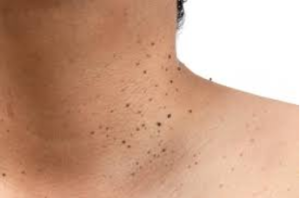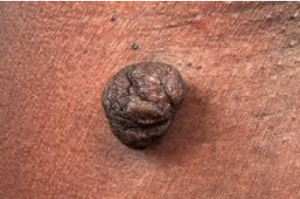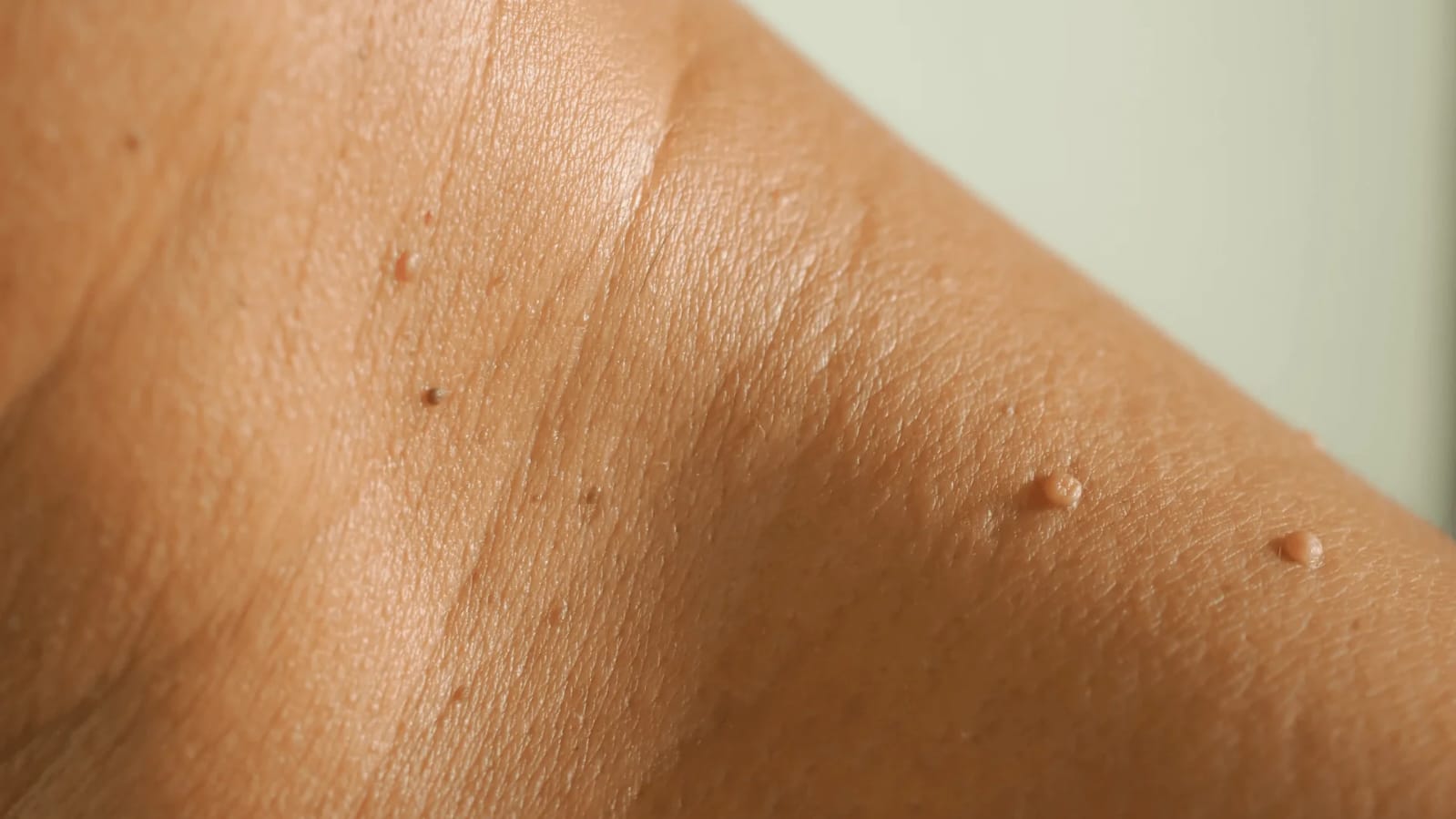Introduction
Skin tags, also known as acrochordons, are small, soft, benign growths that commonly appear on the skin’s surface. While harmless, they can be a source of cosmetic concern for many people, especially when they occur in visible areas such as the neck, face, or underarms. In the UK, skin tags are a common dermatological issue, affecting a significant portion of the population, particularly as they age. Here at Radiant we regularly reduce/remove skin tags with The Plasma Pen for a pain free, needle free approach with no downtime. This guide aims to provide a thorough understanding of what skin tags are, their causes, symptoms, treatment options, and when to seek medical advice.
What Are Skin Tags?
Skin tags are benign (non-cancerous) growths that appear as small, soft pieces of skin hanging off the body. They are typically flesh-coloured, though they can sometimes be slightly darker or lighter than the surrounding skin. Skin tags are usually smooth or slightly wrinkled and may be attached to the skin by a narrow stalk called a peduncle. They can vary in size, from a few millimetres to a centimetre or more in diameter.
 Skin tags can appear almost anywhere on the body, but they are most commonly found in areas where the skin folds or creases, such as:
Skin tags can appear almost anywhere on the body, but they are most commonly found in areas where the skin folds or creases, such as:
- Neck
- Underarms
- Eyelids
- Groin
- Under the breasts
While skin tags are not harmful, they can be bothersome, especially if they are located in areas where they rub against clothing, jewellery, or skin, leading to irritation or discomfort.
Causes of Skin Tags
The exact cause of skin tags is not fully understood, but several factors are believed to contribute to their development:
- Friction and Skin Rubbing:
- Skin tags often occur in areas where skin-to-skin friction is common. This is why they are frequently found in skin folds or where clothing rubs against the skin. Repeated friction can cause the skin to grow in a way that leads to the formation of tags.
- Age:
- Skin tags are more common in middle-aged and older adults. As the skin ages, it becomes more prone to developing growths such as skin tags.
- Genetics:
- There is evidence to suggest that skin tags may run in families, indicating a genetic predisposition to developing these growths.
- Obesity:
- Overweight and obese individuals are more likely to develop skin tags, possibly due to increased skin friction in areas where the skin folds.
- Hormonal Changes:
- Hormonal changes, particularly during pregnancy, can lead to the development of skin tags. Pregnant women may notice an increase in skin tags, especially during the second and third trimesters.
- Metabolic Syndromes:
- Some studies have linked skin tags to metabolic syndromes, including insulin resistance and type 2 diabetes. While the exact connection is unclear, it is believed that these conditions may promote the growth of skin tags.
- HPV (Human Papillomavirus):
- Some research suggests a possible link between certain strains of HPV and the development of skin tags. However, this connection is not yet fully understood and requires further investigation.
Symptoms of Skin Tags
Skin tags are generally asymptomatic, meaning they do not cause symptoms. However, their appearance can sometimes lead to cosmetic concerns. The key characteristics of skin tags include:

- Appearance: Small, soft, flesh-coloured or slightly pigmented growths that hang off the skin. They can be smooth or slightly wrinkled and are typically attached to the skin by a narrow stalk.
- Size: Skin tags can vary in size, from tiny (1-2 mm) to more prominent (up to 1-2 cm or more).
- Location: Commonly found in areas where the skin folds or where there is friction, such as the neck, armpits, groin, under the breasts, and eyelids.
- Irritation: While skin tags are generally painless, they can become irritated or inflamed if they are frequently rubbed or scratched, or if they are caught on clothing or jewellery.
When to Seek Medical Advice
Although skin tags are usually harmless, there are certain situations where it is advisable to seek medical advice:
- Changes in Appearance:
- If a skin tag changes colour, shape, or size, or if it becomes painful, it is important to consult a healthcare professional. These changes could indicate an underlying condition that requires evaluation.
- Bleeding or Infection:
- If a skin tag becomes irritated, bleeds, or shows signs of infection (such as redness, swelling, or pus), it should be examined professionally.
- Cosmetic Concerns:
- If skin tags are causing distress due to their appearance, removal options should be explored.
- Multiple Skin Tags:
- The sudden appearance of multiple skin tags could be a sign of an underlying health condition, such as metabolic syndrome or diabetes. In such cases, it is advisable to seek medical advice for a thorough evaluation.
Difference between skin tags, moles and warts
Treatment Options for Skin Tags
While skin tags do not usually require treatment, many people choose to have them removed for cosmetic reasons or if they are causing discomfort. There are several treatment options available, both at home and in a clinical setting.
- Home Treatments:
- Over-the-Counter Solutions: There are various over-the-counter products available, such as creams and liquid solutions, designed to dry out and remove skin tags. These products usually contain ingredients like salicylic acid or tea tree oil, which work by causing the skin tag to shrink and eventually fall off.
- Tying Off (Ligation): Some people choose to tie off a skin tag at the base using dental floss or a sterile thread. This method cuts off the blood supply to the skin tag, causing it to dry up and fall off after a few days. However, this method should be used with caution and hygiene is crucial to prevent infection.
- Clinical Treatments:
- Electrocautery/Plasma Pen: Electrocautery/Plasma Pen uses heat generated by electric current/plasma to burn off the skin tag. This method is effective and often used for larger or more stubborn skin tags. Here at Radiant, we opt to use this treatment method to reduce/remove skin tags. The Plasm Pen offers a pain free, needle free approach with no downtime.
- Cryotherapy: Cryotherapy involves freezing the skin tag with liquid nitrogen. The extreme cold causes the skin tag to freeze and fall off within a few days. This method is quick and typically performed by a healthcare professional.
- Excision: In this procedure, a doctor uses a scalpel or surgical scissors to cut off the skin tag. Local anaesthetic is usually applied to numb the area, and the procedure is quick with minimal discomfort.
- Laser Removal: Laser treatment involves using focused light energy to remove the skin tag. This method is precise and minimises the risk of scarring.
- Aftercare:
- Following any treatment for skin tag removal, it is important to keep the area clean and dry to prevent infection. An antibiotic ointment may be recommended to aid healing, and patients should avoid touching or picking at the area.
Prevention of Skin Tags
While it may not be possible to completely prevent skin tags, especially if there is a genetic predisposition, certain measures can help reduce the risk of developing them:
- Maintain a Healthy Weight:
- Maintaining a healthy weight can help reduce skin friction, which is a common trigger for skin tag development.
- Minimise Friction:
- Wearing loose-fitting clothing and avoiding jewellery that rubs against the skin can help prevent irritation that may lead to skin tags.
- Good Skin Care:
- Keeping the skin clean, dry, and moisturised can help reduce the risk of skin tag formation.
- Regular Check-ups:
- Regular skin check-ups with a dermatologist can help monitor any changes in the skin and provide early treatment for skin tags or other skin conditions.
Conclusion
Skin tags are a common dermatological concern in the UK, affecting a large portion of the population, particularly as they age. While generally harmless, skin tags can be bothersome or unsightly, leading many individuals to seek removal. Understanding what skin tags are, their causes, and the various treatment options available is important for making informed decisions about their care. Whether opting for home treatments or professional removal, it is essential to follow proper aftercare to prevent complications. If skin tags cause concern, whether due to their appearance, discomfort, or changes in characteristics, consulting a healthcare professional is always the best course of action.

